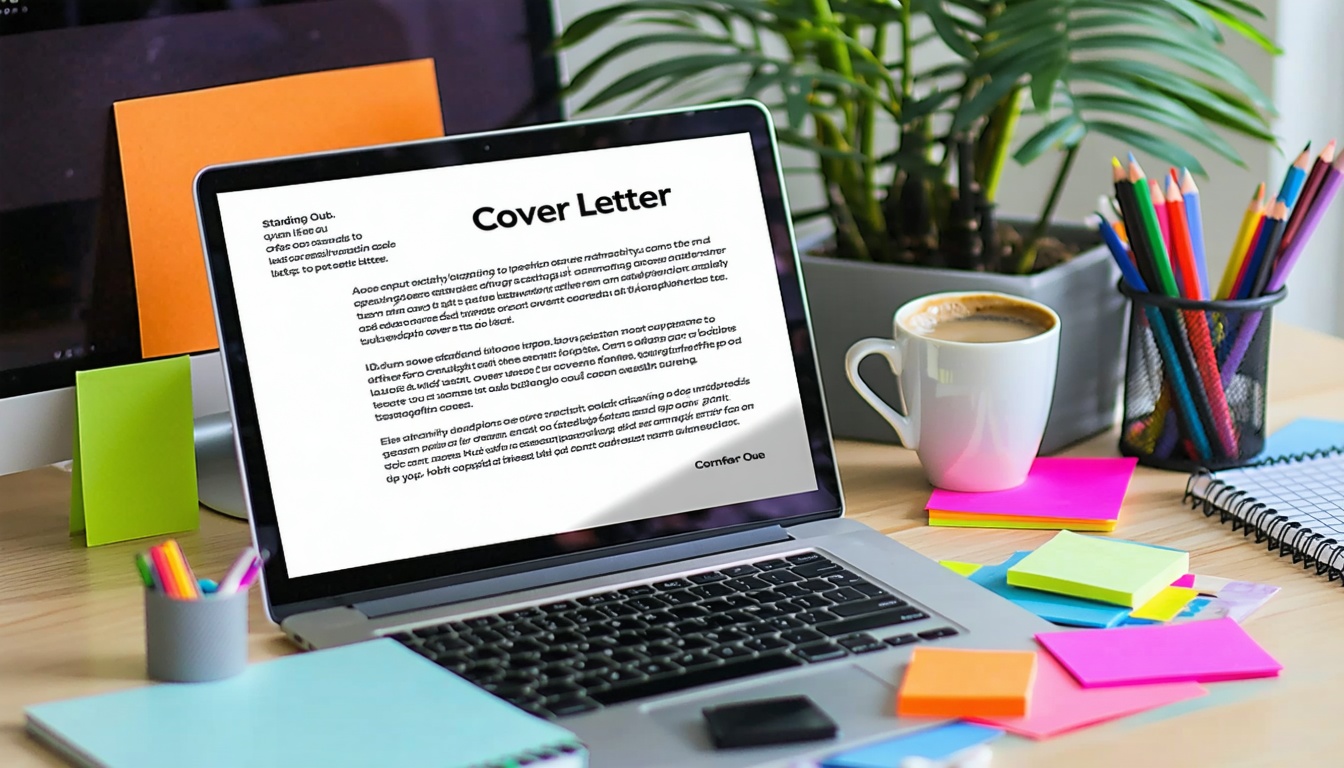
Got a dream job on your radar? You’re going to need more than just a killer resume to land an interview. With dozens—sometimes hundreds—of candidates all vying for the same position, your cover letter is your chance to grab the hiring manager’s attention and say, “Hey, I’m not just another applicant!”
But let’s face it, writing a cover letter that actually stands out is tough. Most end up sounding like boring form letters that recruiters skim through with glazed-over eyes before moving on to the next one.
I’ve been on both sides of this equation—sweating over my own cover letters and reviewing stacks of them as part of hiring teams. So I know firsthand what makes hiring managers sit up and take notice versus what makes them hit the snooze button.
In this guide, I’ll share the simple but powerful techniques that will help your cover letter rise above the competition. No cookie-cutter templates or generic advice—just practical steps that actually work in today’s job market. And if you’re looking to streamline the process, tools like RoboApply’s cover letter builder can help you implement these strategies efficiently.
The Hard Truth About Most Cover Letters
Before we dive into how to make yours shine, let’s acknowledge the uncomfortable reality: most cover letters are forgettable. They follow the same tired formula:
“Dear Hiring Manager, I am writing to express my interest in [position] at [company]. With my background in [field], I believe I would be a valuable addition to your team…”
Sound familiar? Recruiters see this opening so often they could recite it in their sleep. If your cover letter starts this way, you’ve already blended into the crowd.
The second problem? Most cover letters simply rehash the resume. They list the same experiences with slightly different wording but don’t add any new insights. This is a wasted opportunity.
Using a tool like RoboApply can help you avoid these common pitfalls by creating a cover letter that’s actually tailored to the specific job and company, not just a template with a few changed words.
What Actually Makes a Cover Letter Stand Out?
After reviewing thousands of cover letters, I can tell you that the ones that get noticed share a few key characteristics:
- They tell a story rather than list qualifications
- They demonstrate genuine enthusiasm for the specific company
- They connect the dots between past experiences and future contributions
- They sound like they were written by an actual human being, not an AI or template
- They address the company’s needs, not just the applicant’s career goals
According to an analysis by Jobscan, including a cover letter with your resume can increase your interview rate by 3.4 times. That makes your approach critically important.
With RoboApply’s cover letter tools, you can incorporate these standout elements while saving time in the application process. Let’s look at how to implement these principles effectively.
Let’s look at how to incorporate these elements into your cover letter.
Step 1: Start With a Bang, Not a Whimper
Your opening paragraph is make-or-break territory. Instead of the standard “I’m applying for X position,” try one of these approaches:
Example 1: The Personal Connection Opening
When my team deployed your inventory management software last year, I never imagined I'd become so fascinated by its underlying architecture that I'd want to join the company that created it. As the implementation lead who helped cut our warehouse processing time by 34%, I've experienced firsthand how thoughtfully designed your product is—and now I'm excited about the opportunity to bring my technical project management skills to your team as a Product Operations Manager.
This works because it:
- Establishes a genuine connection to the company
- Shows you’ve had positive experiences with their product
- Immediately mentions a quantifiable achievement
- Doesn’t sound like every other cover letter
Research from Harvard Business Review indicates that personalization remains the most crucial element of an effective cover letter. This approach puts personalization front and center.
Example 2: The Problem-Solver Opening
After reading about Greenway Solar's challenge in scaling residential installations to meet growing demand, I couldn't help but see parallels to the logistical puzzle I solved at Suntech Systems, where I developed a crew deployment strategy that increased installation capacity by 65% without adding personnel. I'm applying for the Operations Director position because I believe my experience building efficient field service teams could help Greenway achieve similar results during this critical growth phase.
This approach demonstrates:
- You’ve researched their specific business challenges
- You’ve solved similar problems before
- You’re thinking about their needs, not just your career
- You have concrete, measurable achievements
For more ideas on how to begin your cover letter with impact, check out our guide on great cover letter opening sentences.
Step 2: Don’t Just Say You’re Qualified, Show It With Stories
The middle section of most cover letters contains vague statements like “I am detail-oriented” or “I have strong communication skills.” Instead, tell a brief story that illustrates these qualities in action.
Example 3: The Results-Focused Story
When I joined the marketing team at TechStart, our email open rates hovered around 12%—well below industry average. Rather than accepting this as "normal," I dove deep into our audience data, segmented our subscriber base, and developed personalized content streams for different user types. Within three months, our open rates climbed to 28%, and conversion rates improved by 15%. This data-driven approach taught me that marketing success isn't about following trends but about understanding what makes your specific audience click.
This experience has prepared me to tackle the audience growth challenges outlined in your Digital Marketing Manager posting, where you mentioned the need for someone who can "revitalize engagement with dormant segments."
This example:
- Uses specific numbers to quantify success
- Shows your thought process, not just outcomes
- Directly connects your experience to their stated needs
- Demonstrates you actually read the job posting carefully
Many job seekers find the STAR method (Situation, Task, Action, Result) particularly effective for structuring these examples in their cover letters.
According to LinkedIn’s Global Talent Trends report, candidates who demonstrate company knowledge and specific achievements are much more likely to get an interview.
Step 3: Address the “Why Them” Question Before They Ask It
One of the most common questions hiring managers have when reading a cover letter is, “Why us specifically? Is this person applying everywhere, or do they genuinely want to work here?”
Most cover letters include a token sentence about admiring the company, but it’s usually so generic it could apply to any employer. Stand out by showing you’ve done your homework:
Example 4: The “Why This Company” Paragraph
LevelUp Learning's approach to educational technology stands out in the crowded edtech space because of your commitment to teacher input throughout the development process. As someone who began my career in the classroom before moving into curriculum design, I've seen firsthand how many educational tools fail because they don't address teachers' actual pain points. Your recent case study about the collaborative development of your reading assessment platform with educators in low-resource districts particularly resonated with me, as it aligns with my belief that educational technology should serve all students, not just those in well-funded schools.
This shows:
- Specific knowledge about what makes the company different
- Familiarity with their recent projects or publications
- Alignment with their values, not just interest in their status or brand
- A thoughtful reason why you’re attracted to their specific approach
A study by TopResume found that 68% of recruiters consider a tailored cover letter a sign of a candidate’s genuine interest in the position.
Step 4: Close With Confidence, Not Desperation
The closing paragraph is where many cover letters fall flat with generic statements like “Thank you for your consideration. I look forward to hearing from you.”
A stronger closing reinforces your value and expresses confidence:
Example 5: The Confident Close
Based on my track record of increasing client retention by developing data-informed customer success strategies, I'm confident I can help Salient CRM achieve the retention improvements you're targeting this year. I'd welcome the opportunity to discuss how my approach could be tailored to your specific client base and product suite. I'll follow up next week to see if we can schedule a conversation about the Customer Success Director role and how my experience aligns with your goals for the department.
This closing:
- Reiterates your specific value proposition
- Shows confidence without arrogance
- Indicates you’re proactive and will follow up
- Focuses on their goals, not just your desire for an interview
For more guidance on effectively ending your cover letter, see our resource on how to end a cover letter.
Different situations call for different approaches. Here are examples for various scenarios:
Example 6: When You’re Changing Careers
Dear Ms. Johnson,
"We need someone who understands both the creative and business sides of publishing." These words from your Editorial Project Manager job posting jumped out at me because they perfectly describe the unique perspective I've developed over my ten years in corporate marketing.
While I haven't held the title of Editor before, my role as Marketing Content Director at Reynolds Industries has prepared me surprisingly well for this position. For the past three years, I've managed our company's publishing calendar for both print and digital content, collaborating with a team of five writers to produce materials that maintain consistent voice while meeting tight deadlines. I've also been responsible for aligning our content strategy with business objectives, resulting in a 27% increase in lead generation from our thought leadership pieces.
What draws me to book publishing after a decade in marketing is the opportunity to dedicate myself fully to the craft of developing quality written work. I've been moonlighting as a developmental editor for three self-published authors, helping them shape manuscripts that have collectively sold over 15,000 copies. This experience confirmed what I've long suspected: my true passion lies in bringing other people's stories to life through the editing process.
Granite House Publishing's focus on business and professional development books makes this transition especially fitting, as I can contribute both editorial skills and industry knowledge that will help position these titles for their target readers. I was particularly impressed by your recent release "Leadership in Context," which approaches management principles with the kind of practical framing I've found most effective in corporate environments.
I'd welcome the chance to discuss how my background in content strategy and project management, combined with my editing experience and business acumen, would bring a valuable perspective to your editorial team. I'll follow up next week to see if we might arrange a conversation.
Thank you for considering a non-traditional candidate,
Michael Rodriguez
This career-change cover letter works because it:
- Addresses the career change directly instead of hoping no one notices
- Draws parallels between previous experience and the new role
- Explains the motivation for the change
- Highlights relevant transferable skills with specific examples
- Shows knowledge of the company’s products
If you’re changing careers, check out our guide on how to express yourself effectively in a cover letter for more tips on communicating your transition.
Example 7: For a Highly Competitive Position
Dear Hiring Team at Vertex AI,
When DeepMind's AlphaFold made headlines for solving the protein folding problem, I stayed up all night reading the technical paper and reimplementing parts of the algorithm just to understand how they'd achieved such a breakthrough. This insatiable curiosity about cutting-edge AI systems is what has driven my career from academic research to applied machine learning—and it's why I'm excited about the Machine Learning Engineer position at Vertex AI.
At Quantum Analytics, I've been leading the development of recommendation systems that balance computational efficiency with performance. My most significant contribution was redesigning our embedding framework to reduce inference time by 74% while maintaining accuracy within 0.5% of our previous benchmark. This required deep knowledge of both the theoretical foundations of our models and the practical constraints of deploying them at scale—a combination that I understand is crucial for your work on optimizing large language models.
What particularly interests me about Vertex AI is your focus on both advancing the state of the art and making these advances accessible to organizations with limited ML expertise. This aligns with my own belief that the biggest impact in AI will come not just from theoretical breakthroughs but from making existing capabilities more widely deployable.
I've been following your team's research publications on model compression techniques, and your recent paper on quantization-aware training for transformer architectures influenced my approach to optimizing our own models. I would be thrilled to contribute to work that not only pushes technical boundaries but also expands who can benefit from these technologies.
I've attached my resume detailing my technical qualifications and projects, but I'd welcome the opportunity to discuss how my expertise in optimization techniques and distributed training could support Vertex AI's mission. I'll reach out next week to explore the possibility of a conversation.
With enthusiasm for your team's work,
Aisha Patel
This example stands out for a competitive tech role because it:
- Demonstrates genuine passion for the field with a specific example
- Shows technical expertise through detailed descriptions of relevant work
- References the company’s research, showing familiarity with their contributions
- Aligns with their unique approach and philosophy
- Balances technical details with clear communication
For competitive positions, demonstrating your essential cover letter qualities is crucial to getting noticed.
Example 8: For an Entry-Level Position
Dear Mr. Thomas,
During my junior year internship with City Council Member Williams, I witnessed firsthand how public policy decisions affect real people in our community. One afternoon, while organizing constituent emails, I noticed a pattern of concerns about a proposed zoning change that would eliminate the only grocery store in a low-income neighborhood. This observation led to a community forum that ultimately modified the proposal to preserve food access while still allowing development. That experience showed me the importance of attentive data analysis in public service—and it's why I'm excited about the Research Assistant position with the Urban Policy Institute.
As a recent graduate with a B.A. in Political Science from State University, I've developed strong research and analytical skills through coursework and practical experiences. For my senior thesis, I compiled and analyzed five years of public transit data to examine equity in service distribution across neighborhoods of different socioeconomic levels. This project required me to clean messy datasets, conduct statistical analysis using R, and present complex findings in accessible language—all skills mentioned in your job description.
What attracts me specifically to the Urban Policy Institute is your focus on evidence-based recommendations that directly inform local government decisions. Your recent report on affordable housing incentives, which was adopted by three metropolitan areas, demonstrates exactly the kind of practical impact I hope to contribute to. I'm particularly interested in your upcoming project on transportation equity, as it connects directly with my research interests and previous work.
Although I may have less professional experience than some candidates, my combination of technical skills, research background, and genuine passion for urban policy makes me eager to grow with your organization. I would welcome the opportunity to discuss how I could contribute to your research team while developing my capabilities in this field.
I appreciate your consideration and look forward to potentially working together.
Sincerely,
Taylor Washington
This entry-level cover letter stands out because it:
- Begins with a story that shows relevant experience and values
- Is honest about being early-career without being apologetic
- Connects classroom learning to practical applications
- Shows knowledge of the organization’s work and impact
- Demonstrates enthusiasm and willingness to learn
Recent graduates can find more guidance in our articles on writing a cover letter with no experience and crafting the perfect cover letter for fresher job seekers.
Common Cover Letter Mistakes That Kill Your Chances
Now that you’ve seen what works, let’s talk about what to avoid:
1. Being Too Generic
If you could swap out the company name and job title and send the exact same letter to another employer, it’s too generic. Personalization isn’t just a nice touch—it’s essential.
Our article on how not to write a cover letter provides more examples of common mistakes to avoid.
2. Focusing on What You Want, Not What They Need
A cover letter that dwells on how the job fits into your career plan or how excited you are about the opportunity to learn new skills is missing the point. Focus instead on what you bring to them.
According to a Society for Human Resource Management (SHRM) study, achievement-focused statements are 52% more effective at capturing a hiring manager’s attention than duty-based descriptions.
3. Repeating Your Resume
Your cover letter should complement your resume, not duplicate it. Use this space to tell stories that bring your experiences to life and show the person behind the qualifications.
For guidance on the differences between these documents, check out our article on do I need a cover letter and a resume?
4. Being Too Formal or Too Casual
Many cover letters suffer from overly stiff, formal language: “I wish to express my sincere interest in the aforementioned position.” Others go too far in the casual direction: “Hey guys! I’d be PERFECT for this role!” Find a middle ground—professional but conversational.
If you’re unsure about salutations, our guide on what is the best greeting for a cover letter? can help you start on the right note.
5. Apologizing for Missing Qualifications
Drawing attention to what you lack is rarely a good strategy. Instead, emphasize what you do bring to the table and how your unique background provides value.
Tools to Help Your Cover Letter Stand Out
Writing a stellar cover letter takes effort, but you don’t have to start from scratch. RoboApply’s cover letter builder helps you create personalized, compelling cover letters by analyzing both your resume and the specific job description. Unlike basic templates, it helps you identify key selling points and ensures you’re addressing the company’s actual needs.
If you’re looking for inspiration, check out these resources:
- 10 proven ways to write an effective cover letter
- Cover letter stand out tips
- How to write a cover letter that will get you a job
Beyond just creating documents, RoboApply streamlines your entire application process across platforms like LinkedIn, Indeed, Dice, and ZipRecruiter—saving you hours of repetitive work so you can focus on customizing your approach for each opportunity.
Cover Letter Checklist: Final Steps Before Sending
Before you hit send, make sure your cover letter:
- Addresses a specific person (whenever possible)
- Opens with an engaging hook that’s unique to this application
- Includes specific examples or stories that illustrate your qualifications
- Demonstrates knowledge of the company beyond what’s in the job posting
- Connects your past achievements to their current needs
- Has a confident, actionable closing
- Is free of typos, grammatical errors, and formatting issues
- Sounds like you, not a template
- Is one page or less
For more on appropriate length, check out our article on how long should a cover letter be.
Bottom Line: It’s About Connection, Not Perfection
The most effective cover letters create a human connection. They give the hiring manager a glimpse of the person behind the resume and a preview of what you’d be like to work with. Perfect formatting and fancy language matter far less than authenticity and a clear demonstration that you understand what they need and can deliver it.
Remember, your cover letter isn’t just another item to check off your application to-do list—it’s a powerful tool that can open doors that might otherwise remain closed. Take the time to craft something memorable, and it will pay dividends in your job search.
Looking for a more efficient way to craft personalized cover letters? Check out RoboApply’s suite of job application tools designed to streamline your entire job search process.
Frequently Asked Questions
How much should I customize my cover letter for each job?
Significantly. At minimum, research the company, understand their specific needs for this role, and tailor your examples to show relevant experience. Generic cover letters are easily spotted and rarely effective. According to a JobScan study, 63% of recruiters want to see cover letters customized to their open position.
Should I address employment gaps in my cover letter?
If you have a significant gap, it’s often better to address it briefly and positively rather than leave the employer wondering. Focus on any skills or perspectives you gained during that time that might benefit the employer. Read more about explaining gaps in your cover letter.
Is it okay to use humor in a cover letter?
Light humor can work if it feels natural and appropriate for the company culture, but err on the side of professionalism. A cover letter that tries too hard to be funny can come across as not taking the opportunity seriously. For more on striking the right tone, see what should a good cover letter include?
How do I stand out when applying to a very large company?
Research specific teams or recent projects within the larger organization. Mentioning these shows you’re interested in their particular department, not just the big-name company. Also, try to network with current employees who might provide insights or even referrals.
What if the job posting doesn’t include much information about the role?
Look beyond the posting. Research the company website, LinkedIn profiles of people in similar roles, and industry trends. You can also reach out to the HR department with specific questions about the position before applying. Check out what is the golden tip for a cover letter? for more insights.
Should I follow up after sending my cover letter?
Yes, if possible. Unless the posting specifically says “no follow-up,” a polite check-in about a week after submitting your application shows initiative. Keep it brief and professional, and use it as an opportunity to reiterate your interest.
How personal should I get in my cover letter?
Include personal anecdotes only if they directly relate to your qualifications or fit for the role. Your passion for mountain climbing might be relevant for an outdoor gear company but probably not for an accounting firm. For more guidance, see should a cover letter include personal pronouns?
Does design matter for a cover letter?
For most positions, clean and professional formatting matters more than creative design. However, for roles in creative fields like graphic design or advertising, thoughtful design can demonstrate your skills. Always ensure readability comes first. You might find our article on cover letter justified or left alignment helpful.
What’s the biggest mistake people make in cover letters?
The biggest mistake is failing to show why you’re interested in this specific company and role. Generic letters that could be sent to any employer signal a lack of genuine interest or effort. Learn more about cover letter etiquette to avoid common pitfalls.
How do I make my cover letter stand out if I have limited experience?
Focus on transferable skills from coursework, internships, volunteer work, or personal projects. Use specific stories that demonstrate your potential, work ethic, and eagerness to learn. For entry-level positions, showing the right attitude and growth potential can compensate for limited experience. Check out our guide on cover letter examples for internship success.
Want to simplify your job search? Visit RoboApply.com for tools to help you create impressive cover letters and manage applications across multiple job boards from one dashboard. let’s acknowledge the uncomfortable reality: most cover letters are forgettable. They follow the same tired formula:
“Dear Hiring Manager, I am writing to express my interest in [position] at [company]. With my background in [field], I believe I would be a valuable addition to your team…”
Sound familiar? Recruiters see this opening so often they could recite it in their sleep. If your cover letter starts this way, you’ve already blended into the crowd.
The second problem? Most cover letters simply rehash the resume. They list the same experiences with slightly different wording but don’t add any new insights. This is a wasted opportunity.
What Actually Makes a Cover Letter Stand Out?
After reviewing thousands of cover letters, I can tell you that the ones that get noticed share a few key characteristics:
- They tell a story rather than list qualifications
- They demonstrate genuine enthusiasm for the specific company
- They connect the dots between past experiences and future contributions
- They sound like they were written by an actual human being, not an AI or template
- They address the company’s needs, not just the applicant’s career goals
Let’s look at how to incorporate these elements into your cover letter.
Step 1: Start With a Bang, Not a Whimper
Your opening paragraph is make-or-break territory. Instead of the standard “I’m applying for X position,” try one of these approaches:
Example 1: The Personal Connection Opening
When my team deployed your inventory management software last year, I never imagined I'd become so fascinated by its underlying architecture that I'd want to join the company that created it. As the implementation lead who helped cut our warehouse processing time by 34%, I've experienced firsthand how thoughtfully designed your product is—and now I'm excited about the opportunity to bring my technical project management skills to your team as a Product Operations Manager.
This works because it:
- Establishes a genuine connection to the company
- Shows you’ve had positive experiences with their product
- Immediately mentions a quantifiable achievement
- Doesn’t sound like every other cover letter
Example 2: The Problem-Solver Opening
After reading about Greenway Solar's challenge in scaling residential installations to meet growing demand, I couldn't help but see parallels to the logistical puzzle I solved at Suntech Systems, where I developed a crew deployment strategy that increased installation capacity by 65% without adding personnel. I'm applying for the Operations Director position because I believe my experience building efficient field service teams could help Greenway achieve similar results during this critical growth phase.
This approach demonstrates:
- You’ve researched their specific business challenges
- You’ve solved similar problems before
- You’re thinking about their needs, not just your career
- You have concrete, measurable
Step 2: Don’t Just Say You’re Qualified, Show It With Stories
The middle section of most cover letters contains vague statements like “I am detail-oriented” or “I have strong communication skills.” Instead, tell a brief story that illustrates these qualities in action.
Example 3: The Results-Focused Story
When I joined the marketing team at TechStart, our email open rates hovered around 12%—well below industry average. Rather than accepting this as "normal," I dove deep into our audience data, segmented our subscriber base, and developed personalized content streams for different user types. Within three months, our open rates climbed to 28%, and conversion rates improved by 15%. This data-driven approach taught me that marketing success isn't about following trends but about understanding what makes your specific audience click.
This experience has prepared me to tackle the audience growth challenges outlined in your Digital Marketing Manager posting, where you mentioned the need for someone who can "revitalize engagement with dormant segments."
This example:
- Uses specific numbers to quantify success
- Shows your thought process, not just outcomes
- Directly connects your experience to their stated needs
- Demonstrates you actually read the job posting carefully
Step 3: Address the “Why Them” Question Before They Ask It
One of the most common questions hiring managers have when reading a cover letter is, “Why us specifically? Is this person applying everywhere, or do they genuinely want to work here?”
Most cover letters include a token sentence about admiring the company, but it’s usually so generic it could apply to any employer. Stand out by showing you’ve done your homework:
Example 4: The “Why This Company” Paragraph
LevelUp Learning's approach to educational technology stands out in the crowded edtech space because of your commitment to teacher input throughout the development process. As someone who began my career in the classroom before moving into curriculum design, I've seen firsthand how many educational tools fail because they don't address teachers' actual pain points. Your recent case study about the collaborative development of your reading assessment platform with educators in low-resource districts particularly resonated with me, as it aligns with my belief that educational technology should serve all students, not just those in well-funded schools.
This shows:
- Specific knowledge about what makes the company different
- Familiarity with their recent projects or publications
- Alignment with their values, not just interest in their status or brand
- A thoughtful reason why you’re attracted to their specific approach
Step 4: Close With Confidence, Not Desperation
The closing paragraph is where many cover letters fall flat with generic statements like “Thank you for your consideration. I look forward to hearing from you.”
A stronger closing reinforces your value and expresses confidence:
Example 5: The Confident Close
Based on my track record of increasing client retention by developing data-informed customer success strategies, I'm confident I can help Salient CRM achieve the retention improvements you're targeting this year. I'd welcome the opportunity to discuss how my approach could be tailored to your specific client base and product suite. I'll follow up next week to see if we can schedule a conversation about the Customer Success Director role and how my experience aligns with your goals for the department.
This closing:
- Reiterates your specific value proposition
- Shows confidence without arrogance
- Indicates you’re proactive and will follow up
- Focuses on their goals, not just your desire for an interview
- 5 More Cover Letter Examples That Stand Out in Different Ways
Different situations call for different approaches. Here are examples for various scenarios:
Example 6: When You’re Changing Careers
Dear Ms. Johnson,
"We need someone who understands both the creative and business sides of publishing." These words from your Editorial Project Manager job posting jumped out at me because they perfectly describe the unique perspective I've developed over my ten years in corporate marketing.
While I haven't held the title of Editor before, my role as Marketing Content Director at Reynolds Industries has prepared me surprisingly well for this position. For the past three years, I've managed our company's publishing calendar for both print and digital content, collaborating with a team of five writers to produce materials that maintain consistent voice while meeting tight deadlines. I've also been responsible for aligning our content strategy with business objectives, resulting in a 27% increase in lead generation from our thought leadership pieces.
What draws me to book publishing after a decade in marketing is the opportunity to dedicate myself fully to the craft of developing quality written work. I've been moonlighting as a developmental editor for three self-published authors, helping them shape manuscripts that have collectively sold over 15,000 copies. This experience confirmed what I've long suspected: my true passion lies in bringing other people's stories to life through the editing process.
Granite House Publishing's focus on business and professional development books makes this transition especially fitting, as I can contribute both editorial skills and industry knowledge that will help position these titles for their target readers. I was particularly impressed by your recent release "Leadership in Context," which approaches management principles with the kind of practical framing I've found most effective in corporate environments.
I'd welcome the chance to discuss how my background in content strategy and project management, combined with my editing experience and business acumen, would bring a valuable perspective to your editorial team. I'll follow up next week to see if we might arrange a conversation.
Thank you for considering a non-traditional candidate,
Michael Rodriguez
This career-change cover letter works because it:
- Addresses the career change directly instead of hoping no one notices
- Draws parallels between previous experience and the new role
- Explains the motivation for the change
- Highlights relevant transferable skills with specific examples
- Shows knowledge of the company’s products
Example 7: For a Highly Competitive Position
Dear Hiring Team at Vertex AI,
When DeepMind's AlphaFold made headlines for solving the protein folding problem, I stayed up all night reading the technical paper and reimplementing parts of the algorithm just to understand how they'd achieved such a breakthrough. This insatiable curiosity about cutting-edge AI systems is what has driven my career from academic research to applied machine learning—and it's why I'm excited about the Machine Learning Engineer position at Vertex AI.
At Quantum Analytics, I've been leading the development of recommendation systems that balance computational efficiency with performance. My most significant contribution was redesigning our embedding framework to reduce inference time by 74% while maintaining accuracy within 0.5% of our previous benchmark. This required deep knowledge of both the theoretical foundations of our models and the practical constraints of deploying them at scale—a combination that I understand is crucial for your work on optimizing large language models.
What particularly interests me about Vertex AI is your focus on both advancing the state of the art and making these advances accessible to organizations with limited ML expertise. This aligns with my own belief that the biggest impact in AI will come not just from theoretical breakthroughs but from making existing capabilities more widely deployable.
I've been following your team's research publications on model compression techniques, and your recent paper on quantization-aware training for transformer architectures influenced my approach to optimizing our own models. I would be thrilled to contribute to work that not only pushes technical boundaries but also expands who can benefit from these technologies.
I've attached my resume detailing my technical qualifications and projects, but I'd welcome the opportunity to discuss how my expertise in optimization techniques and distributed training could support Vertex AI's mission. I'll reach out next week to explore the possibility of a conversation.
With enthusiasm for your team's work,
Aisha Patel
This example stands out for a competitive tech role because it:
- Demonstrates genuine passion for the field with a specific example
- Shows technical expertise through detailed descriptions of relevant work
- References the company’s research, showing familiarity with their contributions
- Aligns with their unique approach and philosophy
- Balances technical details with clear communication
Example 8: For an Entry-Level Position
Dear Mr. Thomas,
During my junior year internship with City Council Member Williams, I witnessed firsthand how public policy decisions affect real people in our community. One afternoon, while organizing constituent emails, I noticed a pattern of concerns about a proposed zoning change that would eliminate the only grocery store in a low-income neighborhood. This observation led to a community forum that ultimately modified the proposal to preserve food access while still allowing development. That experience showed me the importance of attentive data analysis in public service—and it's why I'm excited about the Research Assistant position with the Urban Policy Institute.
As a recent graduate with a B.A. in Political Science from State University, I've developed strong research and analytical skills through coursework and practical experiences. For my senior thesis, I compiled and analyzed five years of public transit data to examine equity in service distribution across neighborhoods of different socioeconomic levels. This project required me to clean messy datasets, conduct statistical analysis using R, and present complex findings in accessible language—all skills mentioned in your job description.
What attracts me specifically to the Urban Policy Institute is your focus on evidence-based recommendations that directly inform local government decisions. Your recent report on affordable housing incentives, which was adopted by three metropolitan areas, demonstrates exactly the kind of practical impact I hope to contribute to. I'm particularly interested in your upcoming project on transportation equity, as it connects directly with my research interests and previous work.
Although I may have less professional experience than some candidates, my combination of technical skills, research background, and genuine passion for urban policy makes me eager to grow with your organization. I would welcome the opportunity to discuss how I could contribute to your research team while developing my capabilities in this field.
I appreciate your consideration and look forward to potentially working together.
Sincerely,
Taylor Washington
This entry-level cover letter stands out because it:
- Begins with a story that shows relevant experience and values
- Is honest about being early-career without being apologetic
- Connects classroom learning to practical applications
- Shows knowledge of the organization’s work and impact
- Demonstrates enthusiasm and willingness to learn
Example 9: For a Remote Position
Dear Hiring Manager,
When my previous employer announced we'd be returning to the office full-time last year, I made a deliberate choice to pursue remote work—not just as a preference, but as a professional strategy to maximize my productivity and work quality. As someone who has now successfully led distributed marketing teams for over two years, I was excited to see VirtualBrand's Remote Marketing Director position, which seems tailored to leverage both my leadership experience and my refined remote collaboration skills.
At DigitalEdge, I transitioned our 12-person marketing team to fully remote operations during the pandemic, then developed systems that improved our productivity by 23% compared to our pre-remote metrics. This included implementing asynchronous workflow protocols, creating documentation standards that reduced miscommunication, and establishing a measurement framework that focused on outcomes rather than hours logged.
These remote-specific management approaches have prepared me well for the challenges described in your job posting, particularly "maintaining team cohesion and creativity in a distributed environment." For example, I designed a virtual workshop format that increased cross-functional collaboration by 40% as measured by joint project initiatives, even as our team expanded across six different time zones.
VirtualBrand's commitment to "remote-first, not remote-tolerated" operations strongly resonates with me. I've seen firsthand how a truly remote-optimized culture can unlock talent regardless of location, and I appreciate that you're building this into your company's DNA rather than treating it as a temporary accommodation.
I've attached my resume detailing my marketing expertise and management experience, but I'd welcome a conversation about how my approach to remote leadership aligns with your team's needs. I'm comfortable with interviews at any time in the EST or PST business hours, and can be reached at myemail@email.com or 555-123-4567.
Looking forward to connecting,
Jordan Rivera
This remote job cover letter stands out because it:
- Addresses remote work directly as a professional strategy, not just a perk
- Shows specific experience solving remote work challenges
- Quantifies success in a distributed environment
- Demonstrates familiarity with the company’s remote work philosophy
- Includes practical details about availability across time zones
Example 10: For a Small Business or Startup
Dear Founding Team at GrowLocal,
When my neighborhood farmers market was at risk of shutting down due to declining vendor participation, I couldn't just stand by and watch. Instead, I built a simple online pre-ordering system that allowed regular customers to commit to purchases in advance, giving farmers the confidence to show up each week. Six months later, vendor participation had increased by 35%, and our community maintained access to fresh, local food. This experience taught me that technology doesn't have to be complicated to make a meaningful difference for small businesses—a philosophy I see reflected in GrowLocal's approach.
Your job posting for a "Customer Success Champion who genuinely cares about small business prosperity" caught my attention because it perfectly describes the intersection of my technical skills and personal passion. At Enterprise Solutions Inc., I've been supporting clients with our software implementation, but I've found myself most energized when working with the smaller businesses that often get overlooked by enterprise-focused companies.
What excites me about GrowLocal is your focus on creating accessible tools specifically designed for the challenges and budgets of local retailers. I've been following your company since your feature in Small Business Today last year, and I'm impressed by how you've grown to serve over 200 businesses while maintaining a commitment to personalized support.
I believe my combination of technical troubleshooting abilities and genuine empathy for small business owners makes me well-suited to help your customers succeed with your platform. Having worked in my family's small retail business throughout college, I understand firsthand the resource constraints and multiple-hat-wearing reality of small business operations—insights that I bring to every customer interaction.
I'd welcome the opportunity to discuss how I could help GrowLocal continue to support local businesses while maintaining the personal touch that sets your company apart. I'm available for a conversation at your convenience and can be reached at [phone] or [email].
Looking forward to potentially growing together,
Cameron Lee
This small business/startup cover letter works because it:
- Shows alignment with the company’s mission through a personal story
- Demonstrates understanding of the unique needs of small businesses
- References specific knowledge about the company size and focus
- Balances professional experience with personal connection to the mission
- Has an authentic, conversational tone that fits smaller organization culture
Common Cover Letter Mistakes That Kill Your Chances
Now that you’ve seen what works, let’s talk about what to avoid:
1. Being Too Generic
If you could swap out the company name and job title and send the exact same letter to another employer, it’s too generic. Personalization isn’t just a nice touch—it’s essential.
2. Focusing on What You Want, Not What They Need
A cover letter that dwells on how the job fits into your career plan or how excited you are about the opportunity to learn new skills is missing the point. Focus instead on what you bring to them.
3. Repeating Your Resume
Your cover letter should complement your resume, not duplicate it. Use this space to tell stories that bring your experiences to life and show the person behind the qualifications.
4. Being Too Formal or Too Casual
Many cover letters suffer from overly stiff, formal language: “I wish to express my sincere interest in the aforementioned position.” Others go too far in the casual direction: “Hey guys! I’d be PERFECT for this role!” Find a middle ground—professional but conversational.
5. Apologizing for Missing Qualifications
Drawing attention to what you lack is rarely a good strategy. Instead, emphasize what you do bring to the table and how your unique background provides value.
Tools to Help Your Cover Letter Stand Out
Writing a stellar cover letter takes effort, but you don’t have to start from scratch. RoboApply’s cover letter builder helps you create personalized, compelling cover letters by analyzing both your resume and the specific job description. Unlike basic templates, it helps you identify key selling points and ensures you’re addressing the company’s actual needs.
Beyond just creating documents, RoboApply streamlines your entire application process across platforms like LinkedIn, Indeed, Dice, and ZipRecruiter—saving you hours of repetitive work so you can focus on customizing your approach for each opportunity.
Cover Letter Checklist: Final Steps Before Sending
Before you hit send, make sure your cover letter:
- Addresses a specific person (whenever possible)
- Opens with an engaging hook that’s unique to this application
- Includes specific examples or stories that illustrate your qualifications
- Demonstrates knowledge of the company beyond what’s in the job posting
- Connects your past achievements to their current needs
- Has a confident, actionable closing
- Is free of typos, grammatical errors, and formatting issues
- Sounds like you, not a template
- Is one page or less
Bottom Line: It’s About Connection, Not Perfection
The most effective cover letters create a human connection. They give the hiring manager a glimpse of the person behind the resume and a preview of what you’d be like to work with. Perfect formatting and fancy language matter far less than authenticity and a clear demonstration that you understand what they need and can deliver it.
Remember, your cover letter isn’t just another item to check off your application to-do list—it’s a powerful tool that can open doors that might otherwise remain closed. Take the time to craft something memorable, and it will pay dividends in your job search.
Ready to create cover letters that actually get noticed? Try RoboApply for free and see how the right tools can make the process easier while delivering better results.
Frequently Asked Questions
How much should I customize my cover letter for each job?
Significantly. At minimum, research the company, understand their specific needs for this role, and tailor your examples to show relevant experience. Generic cover letters are easily spotted and rarely effective.
Should I address employment gaps in my cover letter?
If you have a significant gap, it’s often better to address it briefly and positively rather than leave the employer wondering. Focus on any skills or perspectives you gained during that time that might benefit the employer.
Is it okay to use humor in a cover letter?
Light humor can work if it feels natural and appropriate for the company culture, but err on the side of professionalism. A cover letter that tries too hard to be funny can come across as not taking the opportunity seriously.
How do I stand out when applying to a very large company?
Research specific teams or recent projects within the larger organization. Mentioning these shows you’re interested in their particular department, not just the big-name company. Also, try to network with current employees who might provide insights or even referrals.
What if the job posting doesn’t include much information about the role?
Look beyond the posting. Research the company website, LinkedIn profiles of people in similar roles, and industry trends. You can also reach out to the HR department with specific questions about the position before applying.
Should I follow up after sending my cover letter?
Yes, if possible. Unless the posting specifically says “no follow-up,” a polite check-in about a week after submitting your application shows initiative. Keep it brief and professional, and use it as an opportunity to reiterate your interest.
How personal should I get in my cover letter?
Include personal anecdotes only if they directly relate to your qualifications or fit for the role. Your passion for mountain climbing might be relevant for an outdoor gear company but probably not for an accounting firm.
Does design matter for a cover letter?
For most positions, clean and professional formatting matters more than creative design. However, for roles in creative fields like graphic design or advertising, thoughtful design can demonstrate your skills. Always ensure readability comes first.
What’s the biggest mistake people make in cover letters?
The biggest mistake is failing to show why you’re interested in this specific company and role. Generic letters that could be sent to any employer signal a lack of genuine interest or effort.
How do I make my cover letter stand out if I have limited experience?
Focus on transferable skills from coursework, internships, volunteer work, or personal projects. Use specific stories that demonstrate your potential, work ethic, and eagerness to learn. For entry-level positions, showing the right attitude and growth potential can compensate for limited experience.
Ready to create cover letters that actually get noticed? Try RoboApply for free and see how the right tools can make the process easier while delivering better results.








